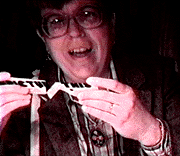
The 3-DVG Workshop
Make any picture 3-D....using only your fingers!
The 3-DVG invention

|
The 3-DVG effect has been routinely called "unbelievable", "incredible", and basically, "must be seen to be believed". And remember, we are talking about any color picture from any magazine although scenic pictures from National Geographic magazine work best because of their size and overall quality. |
|
* Using only your fingers and a bit of practice, the 3-DVG effect will produce a perfect 3-D stereoscopic image, only miniature in size because you are standing four feet away or greater from the picture.
* Using the advanced 3-DVG optical device with variable pinholes and matched optical frames, the 3-DVG effect will produce a 3-D image that rivals a View Master, in spite of limited actual stereopsis and a less than ideal field of view.
*A properly adjusted advanced 3-DVG device can give a person the momentary but distinct impression that they are looking out of a window at the actual scene depicted in a magazine picture.
|
The invention itself, called the 3-DVG, or Three-dimensional Viewing Glasses (U. S. Patent 4,810,057), consists of simple pinhole devices that implement the 3-DVG method of generating 3-D (i.e., stereopsis). The 3-DVG effect was discovered by Kenneth J. Dunkley in 1985 and recognized as a unique visual phenomenon, i.e., the Dunkley Effect, by Professor Bela Julesz in 1989. The discovery of the 3-DVG effect grew out of a study of the differences between pictures and holograms.
The 3-DVG invention was highlighted in the March/April 93 of Stereo World magazine and again in the Nov./Dec. 1994 issue. The SPIE Proceedings also hosted a paper on the device in 1993.
Complementary 3-DVG initiation training devices were provided to interested persons in the visual sciences and details on how to implement the 3-DVG visual process using "two ordinary business cards" were provided freely on the Web from 1998 to 2008.
